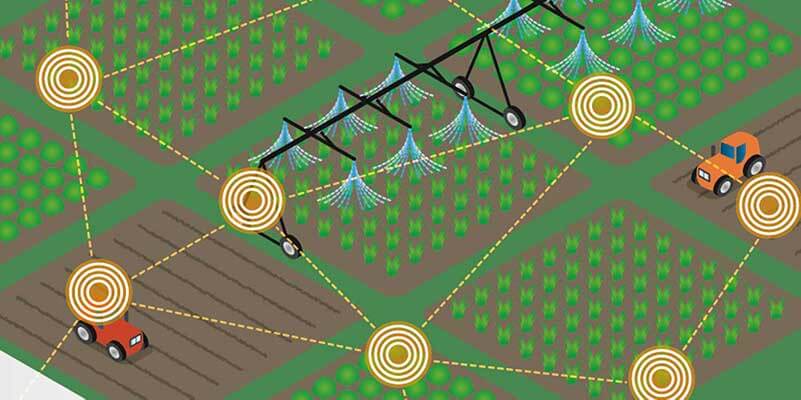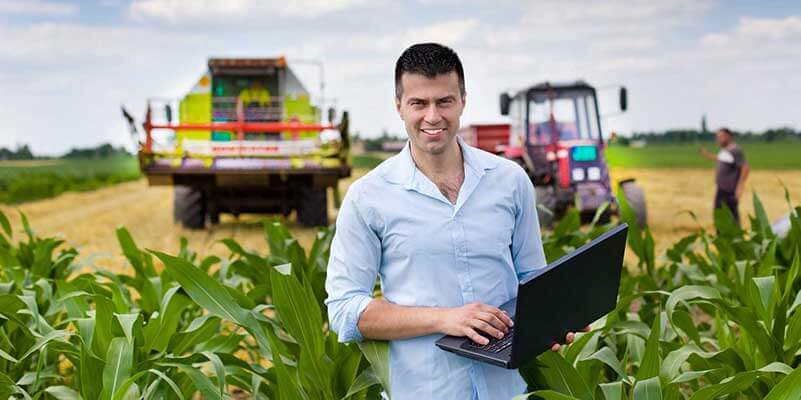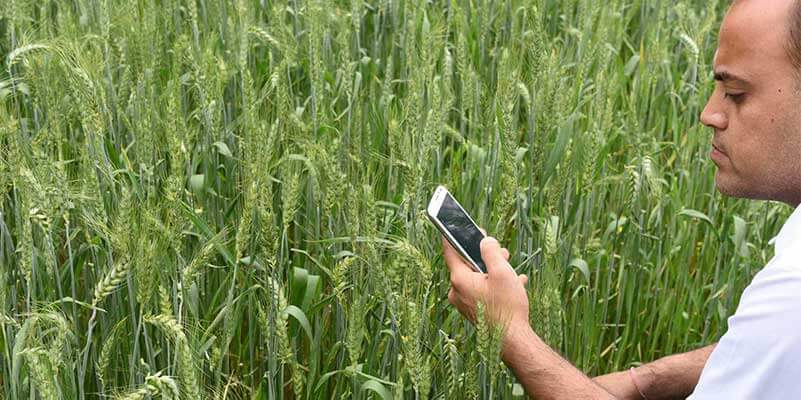Farming has evolved from being considered a primitive occupation into an industry driven by data and modern technologies. Surprised? Don’t be! A farmer today can easily manage acres and acres of crops from his laptop and even map the entire farm on his smartphone. Yes, agriculture is going through radical technological changes. Farmers are starting to use guidance systems to determine the position of their tractors. They use smart devices to turn on and switch off sprinklers, yield monitors to measure harvest volumes, soil moisture sensors, soil density sensors, infrared crop health sensors and a lot more. In the future, smart farming technologies, coupled with data driven precision agriculture, will enable farmers to reduce costs as well as maximise yields and profits. Unmanned Aerial Vehicles will enable farmers to map their operations in real time. This complex assimilation of smart technologies and data driven decisions is known as Precision Agriculture. The popularity this new benchmark is gaining is staggering. Today, tractor manufacturers are incorporating Global Navigation Systems and a variety of other sensors into their models. Gone are the days of labour- intensive farming.
Disruptive technologies in modern day farming create so many opportunities for the new generation, that kids raised on farms today are likely to return to the farming business after college. In this post we look at some of the new technologies that will change the face of global agriculture as we know it. We will also look at some of the potential challenges we face in terms of the acceptance and implementation of these smart farming technologies.
Precision Agriculture can analyse and monitor variable soil characteristics
If you are a farmer or otherwise involved in the agricultural industry, you will know that soil characteristics such as nutrition levels, phosphorous and nitrogen levels etc. vary from one part of the field to another. Smart technologies enable stakeholders such as fertiliser manufacturers, seed salesmen and crop consultants to analyse this variable data easily and advise farmers on optimising their farming practices to produce better yield and reduce wastage. Farmers can easily create precision maps and upload soil data, yield data and aerial imagery into their systems. These new technologies have a significant impact on the environment, such as reduced water usage and decreased use of chemicals.

Sensors enable farmers to set up zones to, for instance, exclude external nutrition or disable chemical spray systems before they reach water supply channels in order to avoid fines and litigation. Gaps and overlaps in plantation can also be avoided through geospatial sensors. Wastage is one of the main problems in traditional agriculture. Precision farming is hugely beneficial in many ways. It provides farmers all across the globe with better prospects and it does its bit for the environment by minimising wastage.
Bluetooth, infrared and GPS as modern day ploughs and scythes. Who would have thought?
In our previous posts we saw how modern day vehicles and almost every other human essential are being touched by smart devices and modern technology. Agriculture and farming are no different. Farms now have tractors with built-in navigation and sensors, monitoring all macroscopic and microscopic elements in the field. John Deere, an industry leading tractor manufacturer, provides multiple sensor options in their tractors where GPD receivers are added to sprayers for better control. Kinze specialises in producing planters and grain charts to evaluate planting and harvesting.
However, no matter how modernised farming may get, the crux will always revolve around three basic procedures:
- The depth of seed implant
- Seed to soil contact
- Seed-to-seed spacing

Kinze’s sensors provide vital information and control over these basic procedures which are essential for maximum output. However, full-scale implementation of such technologies does pose challenges. Some immediate complications that come to mind include terrain difficulties, solar maxes and satellite distribution at higher latitudes. Software systems like those offered by easyfarmmaps.com enable large-scale data collection in the field but they are expensive to install and complex for farmers to learn and process. While big agricultural companies and large firms may have the resources to implement these technologies; small scale farmers and individual owners may not necessarily have those options. Looking at a future where agriculture is dominated by precision and cloud data and supported by advanced infrastructure like smart tractors, unmanned aerial vehicles and wireless technology, we need to make sure that these technologies are simplified to rudimentary levels and made cost-efficient for maximum acceptance across the industry.
Smart pig pens and cow sheds: a better environment for domestic animals
Precision technology may well pave the way for improved animal welfare. One cannot deny that the current livestock environment is extremely hostile. This can change with projects like ALL-SMART-PIGS (funded by the EU) where sensors are used to detect animal needs and relay information to concerned authorities in case of harsh treatment. Healthier animals will mean healthier produce and turn the entire scenario into a win-win situation for farmers and animals. Key factors like feeding efficiency, health data, air quality and more will be consistently monitored and efforts will be made to counter all anomalies. While picturing the concept is easy, the implementation of it will be a lot more challenging. The biggest challenge is to get everything and everyone on board. Then there are infrastructural challenges like unreliable internet connections in rural parts of the world.
Video credits: Youris.com
These issues lead us to the question: what kind of investment is required to make these concepts feasible on a global scale? Will it justify the returns received afterwards? While there is scepticism on one hand, there is also optimism. For instance, consumer pressure for animal welfare is a strong motivator for such technologies in Germany, UK and the Netherlands. Some experts also reported that farmers who used these precision technologies to improve animal health recorded phenomenal results such as increased feed conversion efficiency and improved weights – resulting in increased profits. Some of them have already started expanding operations. It is important that the wide-spread application of such technologies is supported by, for instance, the EU and regulations should be put in place to prevent important and sensitive data from being exploited or violated. Infrastructural capabilities such as broadband penetration and speeds will need to be improved.
Forget Old MacDonald’s Farm, the Farm of the future will be more like Star Trek
In a recent study, team members of the Cow Tracking Project found that it costs farmers $300 each time a cow suffers from mastitis – a fatal udder infection. This cost could be significantly reduced if sensors, monitoring individual cows and their behaviour, send alerts as soon as they detect disease. Such innovative ideas are surfacing all across the world. Take Swiss drone maker SenseFly for instance. They aim at helping agriculture from the air by deploying drones powered by patented software to capture high-resolution pictures of fields. With these images, farmers will be able to analyse crop health and take informed decisions.
Another company, BioCarbon, has created a unique technology that deploys drones for planting a billion trees each year. How great is that! Another example is Dacom, a firm which specialises in creating software and online advisory services for farms and other agricultural institutions and bodies. It allows farmers to use smartphones to monitor water, fertiliser, crop yields, growing conditions and weather patterns. Coming back to the problem of wastage, smart farms of the future will definitely have a handle on it as efficient waste management systems will be in place across the industry. Currently, the agricultural industry uses up a whopping 70% of our fresh water. 60% of this is completely wasted. Smart systems can alert farmers in case of leaks and machine failures and enable them to control water pumps.

Take the Nano Ganesh for example. Indian farmers are using mobile phone-based remote technology to control water flow in pumps, resulting in significant water savings and overall cost reduction. The biggest hurdle is the fact that many farms are not yet connected to the cloud. In order to connect farms of all scales and sizes, major investments need to be made but in regions like Africa, millions of households still rely on subsistence agriculture for survival. While the benefits of smart farms on the future of agriculture are clear, there are still enormous challenges to overcome.
Farmers are using smart technology a lot more than you think!
A recent presentation by experts in Britain illustrated what smart farms of the future may look like. We will have crop scouts inspecting plants and removing weeds, weather intelligent sprayers, drones monitoring cultivable fields and a central hub for data to be relayed and analysed to help farmers make informed decisions! While some niche technologies like N Sensor are still only accessible to large firms, smaller businesses are not far behind when it comes to employing smart techniques to farming. There are already huge numbers of livestock farmers, for instance, who use sensors to track the health and movement of their animals. European governments are showing an increased interest in promoting smart farming as the recent climate change estimates predict an increment in the production potential. The results can be seen too! For instance, 60% of farmlands in Britain are now managed by precision methods including sensor systems, cameras, drones, microphones, virtual field maps, analytics and GPS guided tractors. A new agricultural revolution is on the horizon!
Video credits: Agriculture.com
A great example of precision technology is the N Sensor. It has a cab-mounted tool equipped with sensors at the end. The sensors analyse the colour of growing crops. It can estimate the chlorophyll content, nitrogen requirement and other details. These sensors relay this information to a sprinkler system that will then spray the right amount of fertiliser on that part of the field. The complexity of this precision technology has made it expensive but I am sure that a more wide-spread demand in the future will eventually result in a reduction in costs. Farmers are also realising the importance and benefits of precision farming and are trying to implement the available technologies wherever possible. I am sure that the future of smart farming will see a larger scale demand for such technologies, resulting in decreased costs – leading to even broader implementation of these technologies.
Smart farms are on the rise and smart barns are not far behind!
Have you heard about the new small scale farming service Smart Barn, created by Klein and Althaus in January 2014? It has fifteen customers including hog and soya bean farmers and helps them with monitoring environmental conditions and grain bin temperatures. Other things the farming service monitors include power outage and usage, system status, airflow and ventilation and water pressure. Their systems use the Verizon Wireless Network to map the farm and place sensors after which the information is uploaded and stored in the cloud.
The farmers agree that the system is reliable. Livestock farmers in particular benefit from these technologies as they provide extensive monitoring of health levels which helps increase production. As farmers are able to monitor humidity, temperature, air quality and feeding requirements, better care for the animals can be provided. These techniques can be extended to grain farming and help increase production by 10% in no time. It is interesting to see the diversity of the scale in which precision farming techniques can benefit farmers. From small scale livestock farmers to large scale agricultural firms, all of them are increasingly realising the benefits of these technologies and therefore, wide acceptance is underway. This also presents opportunities for innovators to venture into a new industry and innovate it to exceedingly profitable levels.
Farmers can instantly see the nutrient requirements of their crops
Research is being done into combining data driven technologies with farming algorithms to help farmers get instant notifications about their crops. For instance, farmers have instant access to information about, for instance, phosphorus availability, enabling them to make smarter decisions about fertiliser application. If you take pea and bean crops for instance, poor, untimely or irregular application of fertilisers such as lime can result in a yield reduction of up to 30%. Such mistakes can be eliminated by efficient precision technologies.
The method discussed in the research involves two technologies namely Diffusive Gradients and Portable x-ray fluorescence spectrometry (pXRF). Nutrients like phosphorous are important to crop health but repeated use of these fertilisers in countries like the UK has caused problems like phosphorous leakage, polluting waterways (causing eutrophication) and making crops phosphorous deficient. With these new technologies such inefficiencies can be managed properly. The trials are taking place at Myerscough College under a research agreement signed between Myerscough and Lancaster. Fertilisers have become an integral part of global agricultural practices over the last 5 decades. They provide nutritional benefits to crops and help increase yields and maximise profits. But there have been problems of overuse, leakage, environmental soil pollution etc. that have raised major concerns about fertiliser efficiency. I strongly feel that governments should take interest in research like the one above that aims at optimising the use of fertilisers.
Conclusion
Research into smart farming is happening everywhere and innovators are coming up with technologies that provide agriculture with a base from which to leap into the future. We will see companies like John Deere introducing tractors with smart sensors. Who knows, they might even launch their own line of smart, self-driving farming vehicles in the future! Farms are becoming smarter, livestock is becoming healthier. N Sensor will send vital data to agricultural consultants so that farmers can be advised on how to make better decisions. Concepts like Nano Ganesh will help minimise water wastage and enable farmers to maximise production.
In many ways, the future of agriculture will be governed by precision farming and smart data-driven technologies. Farmers looking for new opportunities will acquire such technologies and reap their benefits. I am looking forward to seeing drones plant billions of trees around the globe every year. Challenges such as major investments, acceptance and knowledge gaps will need to be dealt with by governments and stakeholders in order to realise the full scope of such technological advancements. As is the case with any disruptive innovation – as soon as new technology is accepted and embraced, the costs of such technologies usually decrease soon after.
Share via:


